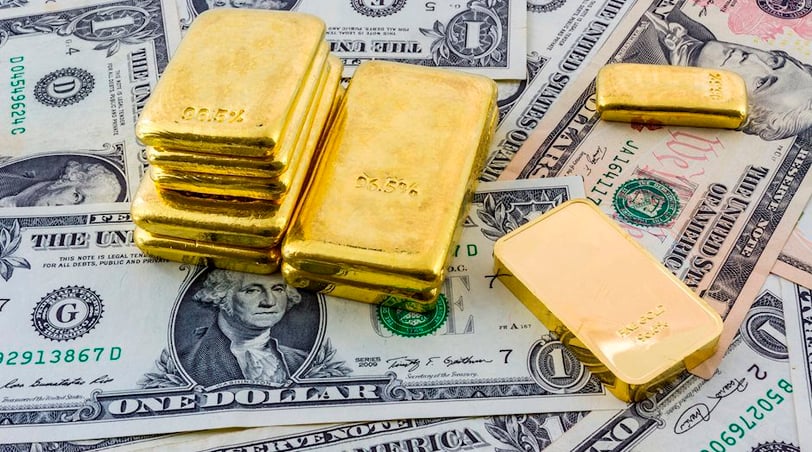Add your promotional text...
Gold's Balancing Act: Trade Wars, Dollar Gains, and Geopolitical Calm
Synopsis: Gold prices experienced modest gains on Tuesday, as trade war fears sparked by President-elect Donald Trump’s tariff threats revived safe-haven demand. However, a stronger dollar and easing geopolitical tensions kept gold's momentum in check. This blog examines the complex factors influencing gold and other metals, alongside broader market impacts.
COMMODITIES
By Ekta Mani
11/26/20243 min read


Gold prices saw a slight recovery in Asian trading on Tuesday, supported by renewed demand for safe-haven assets amid escalating trade war fears. However, gains were limited as the U.S. dollar surged to near-record highs, offsetting investor interest in the yellow metal. These movements come against a backdrop of global economic uncertainty and mixed signals from geopolitical developments.
Trump's Tariff Threats Ignite Market Anxiety
President-elect Donald Trump’s announcement of steep import tariffs jolted global markets, sending ripples across asset classes. Trump vowed to impose a 10% tariff on Chinese imports and a 25% tariff on goods from Canada and Mexico. According to Trump, these measures aim to curb the influx of illegal immigrants and illicit drugs into the United States.
This aggressive stance has renewed fears of a global trade war, particularly with China, one of the world’s largest economies. Beijing has decried the move, raising the likelihood of retaliatory actions, which could exacerbate market instability.
Investors turned to gold as a traditional hedge against such uncertainty, pushing spot gold up 0.1% to $2,628.69 an ounce. Meanwhile, gold futures expiring in December climbed 0.4% to $2,653.75 by 23:24 ET (04:24 GMT).
The Dollar’s Strength Caps Gold’s Potential
Despite the resurgence in safe-haven demand, gold’s gains were muted by a strong U.S. dollar. Following Trump’s tariff threats, the dollar surged, nearing a two-year high reached last week. A robust greenback typically makes gold less attractive to holders of other currencies, tempering the metal’s upward trajectory.
This interplay between haven demand and currency strength highlights the nuanced relationship between gold and macroeconomic indicators.
Middle East Geopolitics: A Mixed Bag for Gold
Geopolitical developments in the Middle East, another key driver of gold prices, have sent mixed signals to the market. Reports suggesting an imminent ceasefire between Israel and Lebanese militant group Hezbollah eased tensions in the region, reducing the urgency for safe-haven assets.
Earlier this year, heightened hostilities in the Middle East, including clashes between Israel and Iran, had significantly bolstered gold prices. While the easing of tensions is a positive development for global stability, it has momentarily dampened the metal’s appeal.
Nevertheless, gold has retained some gains from last week, when renewed tensions between Russia and Ukraine drove investors toward safe havens. Moscow’s threats of nuclear retaliation for Ukraine’s use of Western-made, long-range missiles reignited fears of escalation in Eastern Europe.
Broader Metal Market Movements
Gold wasn’t the only metal reacting to global developments. Other precious and industrial metals saw mixed performances:
Silver: Rose 0.5% to $30.823, reflecting moderate investor interest despite broader market headwinds.
Platinum: Dipped 0.1% to $943.65, under pressure from uncertain demand dynamics.
Copper: Fell 0.3% on the London Metal Exchange to $9,026.50 a ton, while U.S. copper futures expiring in March dropped 0.4% to $4.1453 a pound.
Copper’s decline underscores concerns about economic headwinds for China, the world’s largest importer of the industrial metal. The potential for trade restrictions and slower global growth has weighed heavily on copper prices, which are often seen as a bellwether for economic activity.
Gold’s Role Amid Uncertainty
Gold’s modest gains amid a volatile environment highlight its enduring role as a safe-haven asset. However, its trajectory remains subject to a delicate balance of factors:
Geopolitical Tensions: Fluctuating conflict dynamics in regions like the Middle East and Eastern Europe will continue to influence gold’s appeal.
Trade Policies: Trump’s protectionist measures and the ensuing global economic uncertainty could drive haven demand, though the strength of the U.S. dollar may offset this effect.
Macroeconomic Trends: Broader movements in inflation, interest rates, and currency markets will play a pivotal role in shaping gold prices in the coming months.
Conclusion: Navigating a Volatile Landscape
Gold’s performance this week underscores the complexity of navigating a volatile global landscape. While trade war fears and geopolitical tensions provide a strong case for haven assets, countervailing factors such as a strengthening dollar and easing conflicts can limit gains.
As markets react to Trump’s tariff threats and broader macroeconomic developments, gold investors must remain attuned to both short-term volatility and long-term trends. The yellow metal’s enduring appeal lies in its ability to act as a hedge against uncertainty—whether economic, geopolitical, or financial.
In the weeks ahead, gold’s path will depend on how these competing forces evolve. For now, the market remains a testament to the interplay of fear, policy, and opportunity in shaping investor sentiment.
